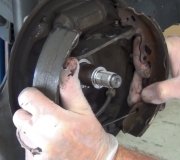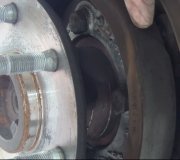Basically I shove the drum on and turn it by hand. If there's little or no drag I pull it off and turn the star wheel about a half turn then try again. I also push in on the drum to hold it tightly against the axle flange. That holds it straight to the shoes. If you let the drum flop around loose it can sit cocked and it will drag giving the impression the shoes are adjusted up too much. Push in, hold it tight with both hands, turn it left and right a couple of inches, and feel if there's any drag. Keep running the star wheel up until you can't get the drum on or it's really tight. At that point back the star wheel off about a half turn and you'll be good to go.
Installing the wheel will also hold the drum straight. To look at it another way, once you think it's adjusted right and you install the wheel, you may find now it's still too loose, then you can adjust it up a little more with a "brake spoon" through the access hole in the backing plate.
As I recall you found the parking brake cables were rusted or over-adjusted. Anything that removes the free play in the strut bar between the two shoes will lead to accelerated lining wear.
If you don't have the shoes adjusted up enough you will have a low brake pedal. If you have them adjusted up too much but you can still force the drum on the linings will wear down quickly until it's time for them to start self-adjusting. The linings are ground to match the diameter of a new drum. In most applications a drum can be machined as much as.060" and still be legal, but that means it has a larger diameter friction surface. The linings will only make contact in the center, (halfway between the top and bottom). Braking power will be reduced until that section wears down and more of the lining makes contact. That's why we tell you to take it easy on your new brakes for the first 100 miles. By "take it easy" I don't mean to barely use the brakes. I mean use them normally with a few hard applications now and then but to not EXPECT too much from them right away. You probably won't be able to lock those brakes up for 100 miles or so. You may notice you have to push on the brake pedal harder than normal but that will improve as more and more of the linings start to make contact with the drums.
Thank you for the donation. You're truly a wonderful human being!
I should mention too that even if you over-adjust the shoes and manage to force the drum on, you'll only wear down less than 1/16" of lining right in the center. That's why I said you're over-thinking the adjustment issue. Be sure the star wheel adjusters are free and the threads can be lightly lubricated, and be sure the shoes are against the large anchor pin on top and there's free play in the strut bar.
The only other thing that can cause rapid wear is if a rubber flex hose is constricted preventing the brake fluid from releasing back to the reservoir or the brake fluid is contaminated with a petroleum product. That will cause rubber parts to swell; in particular the rubber lip seals in the master cylinder. They will grow past the return ports and trap pressurized brake fluid preventing the brakes from releasing. I doubt you have contaminated brake fluid because you'd have dragging and overheated front brakes first. You can tell if any brake is dragging by observing what happens on a slight incline or what happens at a stop light with an automatic transmission. When you release the brakes the truck should creep ahead on its own. If it doesn't, or if it won't creep downhill on an incline when you are in neutral, a brake is dragging. Even an over-adjusted drum brake won't hold the truck from creeping. A non-releasing brake will get hot too so you'll be able to identify which wheel has the problem.
Thursday, May 23rd, 2013 AT 10:51 PM






